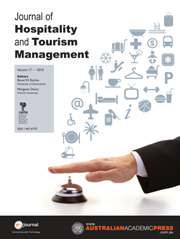Crossref Citations
This article has been cited by the following publications. This list is generated based on data provided by
Crossref.
Bruce Tracey, J.
2014.
A review of human resources management research.
International Journal of Contemporary Hospitality Management,
Vol. 26,
Issue. 5,
p.
679.
Pan, Frank C.
2015.
Practical application of importance-performance analysis in determining critical job satisfaction factors of a tourist hotel.
Tourism Management,
Vol. 46,
Issue. ,
p.
84.
Dai, Weiqi (David)
Mao, Zhenxing (Eddie)
Zhao, Xinyuan (Roy)
and
Mattila, Anna S.
2015.
How does social capital influence the hospitality firm's financial performance? The moderating role of entrepreneurial activities.
International Journal of Hospitality Management,
Vol. 51,
Issue. ,
p.
42.
Ucal Sari, Irem
2017.
A Performance Measurement Model Minimizing Housekeeping Personnel Costs.
International Journal of Fuzzy Systems,
Vol. 19,
Issue. 3,
p.
776.
Samad, Sarminah
2020.
Achieving innovative firm performance through human capital and the effect of social capital.
Management & Marketing. Challenges for the Knowledge Society,
Vol. 15,
Issue. 2,
p.
326.
El-Said, Osman Ahmed
Al Hajri, Bashaer
and
Smith, Michael
2020.
An empirical examination of the antecedents of training transfer in hotels: the moderating role of supervisor support.
International Journal of Contemporary Hospitality Management,
Vol. 32,
Issue. 11,
p.
3391.
Kuo, Chun-Min
Chen, Wen-Yuan
Tseng, Chin-Yao
and
Kao, Chang Ting
2021.
Developing a smart system with Industry 4.0 for customer dissatisfaction.
Industrial Management & Data Systems,
Vol. 121,
Issue. 6,
p.
1353.
Mahato, Manjari
Kumar, Nitish
and
Jena, Lalatendu Kesari
2021.
Re-thinking gig economy in conventional workforce post-COVID-19: a blended approach for upholding fair balance.
Journal of Work-Applied Management,
Vol. 13,
Issue. 2,
p.
261.
Nagpal, Gaurav
Jasti, Naga Vamsi Krishna
Kumar, Alok
and
Gupta, Sachin
2022.
Does Cross-Functional Pedagogy of Teaching a Course Help in Management Education?.
International Journal of Adult Education and Technology,
Vol. 13,
Issue. 1,
p.
1.
Lin, Fang-Yi
2022.
Effectiveness of the talent cultivation training program for industry transformation in Taiwan during the COVID-19 pandemic.
Service Business,
Vol. 16,
Issue. 3,
p.
529.
Chatterjee, Sheshadri
Chaudhuri, Ranjan
Vrontis, Demetris
and
Thrassou, Alkis
2022.
Workforce service quality in the post-COVID-19 era: from the perspective of organisation data-driven competency.
Production Planning & Control,
p.
1.
Tortorella, Guilherme
Prashar, Anupama
Antony, Jiju
Vassolo, Roberto
Mac Cawley, Alejandro
Peimbert Garcia, Rodrigo
and
Nascimento, Daniel Luiz de Mattos
2023.
Soft lean practices and organizational resilience in the service sector.
Management Decision,




